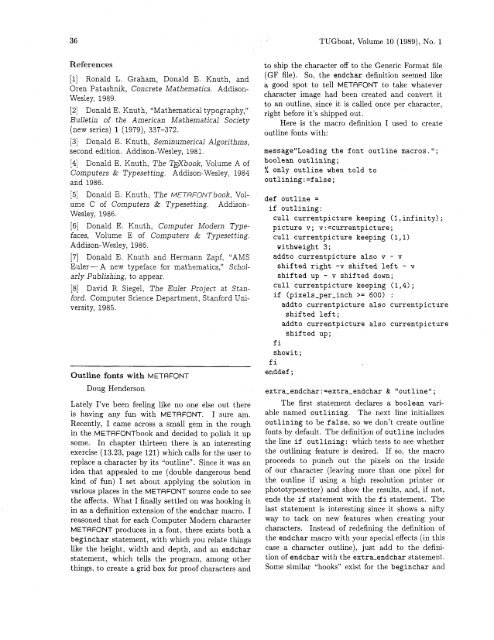Complete issue 10:1 as one pdf - TUG
Complete issue 10:1 as one pdf - TUG
Complete issue 10:1 as one pdf - TUG
Create successful ePaper yourself
Turn your PDF publications into a flip-book with our unique Google optimized e-Paper software.
36 <strong>TUG</strong>boat, Volume <strong>10</strong> (1989), No. 1<br />
References<br />
to ship the character off to the Generic Format file<br />
[I] Ronald L. Graham, Donald E. Knuth, and<br />
(GF file). So, the endchar definition seemed like<br />
Oren Pat<strong>as</strong>hnik, Concrete Mathematics. Addisona<br />
good spot to tell METAFONT to take whatever<br />
Wesley, 1989.<br />
character image had been created and convert it<br />
to an outline, since it is called once per character,<br />
[2] Donald E. Knuth, "Mathematical typography," right before it's shipped out,<br />
Bulletin of the American Mathematical Society<br />
Here is the macro definition I used to create<br />
(new series) 1 (1979), 337-372.<br />
outline fonts with:<br />
[3] Donald E. Knuth, Seminumerical Algorithms,<br />
second edition. Addison-Wesley, 1981.<br />
[4] Donald E. Knuth, The wbook, Volume A of<br />
Computers & Typesetting. Addison-Wesley, 1984<br />
and 1986.<br />
[5] Donald E. Knuth, The METRFONT~OO~, Volume<br />
C of Computers & Typesetting. Addison-<br />
Wesley, 1986.<br />
[6] Donald E. Knuth, Computer Modern Typefaces,<br />
Volume E of Computers & Typesetting.<br />
Addison-Wesley, 1986.<br />
[7] Donald E. Knuth and Hermann Zapf, "AMS<br />
Euler - A new typeface for mathematics," Scholarly<br />
Publishing, to appear.<br />
[8] David R Siegel, The Euler Project at Stanford.<br />
Computer Science Department, Stanford University,<br />
1985.<br />
Outline fonts with METAFONT<br />
Doug Henderson<br />
Lately I've been feeling like no <strong>one</strong> else out there<br />
is having any fun with METAFONT. I sure am.<br />
Recently, I came across a small gem in the rough<br />
in the METAFONTbook and decided to polish it up<br />
some. In chapter thirteen there is an interesting<br />
exercise (13.23, page 121) which calls for the user to<br />
replace a character by its "outline". Since it w<strong>as</strong> an<br />
idea that appealed to me (double dangerous bend<br />
kind of fun) I set about applying the solution in<br />
various places in the METAFONT source code to see<br />
the affects. What I finally settled on w<strong>as</strong> hooking it<br />
in <strong>as</strong> a definition extension of the endchar macro. I<br />
re<strong>as</strong><strong>one</strong>d that for each Computer Modern character<br />
METAFONT produces in a font, there exists both a<br />
beginchar statement, with which you relate things<br />
like the height, width and depth, and an endchar<br />
statement, which tells the program, among other<br />
things, to create a grid box for proof characters and<br />
me~sage~~loading the font outline macros.";<br />
boolean outlining;<br />
% only outline when told to<br />
outlining:=false;<br />
def outline =<br />
if outlining:<br />
cull currentpicture keeping (1,infinity);<br />
picture v; v:=currentpicture;<br />
cull currentpicture keeping (1,l)<br />
withweight 3;<br />
addto currentpicture also v - v<br />
shifted right -V shifted left - v<br />
shifted up - v shifted down;<br />
cull currentpicture keeping (1,4);<br />
if (pixels-per-inch >= 600) :<br />
addto currentpicture also currentpicture<br />
shifted left;<br />
addto currentpicture also currentpicture<br />
shifted up;<br />
f i<br />
showit;<br />
fi<br />
enddef ;<br />
extra-endchar:=extra-endchar & "outline";<br />
The first statement declares a boolean variable<br />
named outlining. The next line initializes<br />
outlining to be false, so we don't create outline<br />
fonts by default. The definition of outline includes<br />
the line if outlining: which tests to see whether<br />
the outlining feature is desired. If so, the macro<br />
proceeds to punch out the pixels on the inside<br />
of our character (leaving more than <strong>one</strong> pixel for<br />
the outline if using a high resolution printer or<br />
phototypesetter) and show the results, and, if not,<br />
ends the if statement with the f i statement. The<br />
l<strong>as</strong>t statement is interesting since it shows a nifty<br />
way to tack on new features when creating your<br />
characters. Instead of redefining the definition of<br />
the endchar macro with your special effects (in this<br />
c<strong>as</strong>e a character outline), just add to the definition<br />
of endchar with the extra-endchar statement.<br />
Some similar "hooks" exist for the beginchar and

















